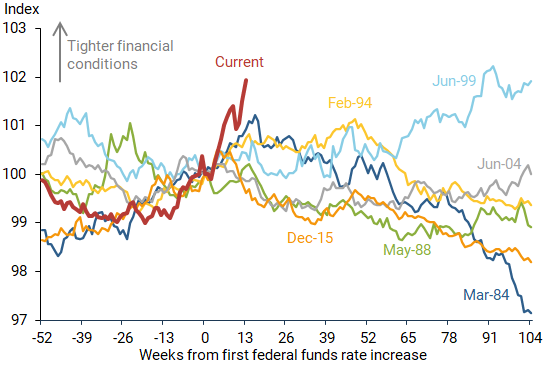I keep running into a lazy consensus around Ukraine – a long, grinding war prosecuted by implacable, iron-fisted Putin pressing crushing energy sanctions until…? The end game is usually hand-waving about “negotiations” that largely assumes Ukrainian capitulation. If those ill-examined assumptions proves wrong, how much will it upend markets? Because the evidence suggests that consensus scenario is wrong.
So what happens if Russia’s energy and consumer goods flows re-start? That is not in most 2023 forecast expectations I’ve seen.
- Russia’s energy flows flood back into global markets. European and global gas prices plummet. Oil prices likely drop too. Those price changes will positively impact everything that depends on energy (real-economy inflationary) and negatively impact mathematically measured inflation (nominally deflationary).**
- A re-start of Russian consumer imports from the West. Russia’s pre-war economy was the same size as Spain, so this won’t move the needle much. But a lot of Europeans – no longer paying an oil/gas war tax – will shift spending more on other stuff. So the global effect will be solidly positive (thus inflationary).
The “hot” war will likely last months. Definitely not years. Only an armchair general could expect humans and machines to keep up this tempo. The rate of equipment loss/depletion is too high. Although human morale – depleted by time and the equipment running down – probably cracks before the hardware does. As the last weeks show, the Russians can’t hold their lines with the men/equipment on hand. So the Russians probably lose heart before the Ukrainians do. Neither can keep up this pace indefinitely.
Per my prior post, the end game is (hopefully) a frozen conflict that stays cold(ish) until past Putin’s sell-by date. In that transition from hot war to frozen conflict, Putin is most likely to move towards re-opening the gas taps.
Putin has to be desperate to re-open the gas taps. Why? Putin needs the money! Public opinion still matters in Russia (as it also matters in China and even – gasp – North Korea). How does Putin distract Russia’s attention away the strategic and military disaster of Ukraine? Engineer a consumer boom. Data are hard to come by, but Russia’s non-oil/gas consumer/producer economy is losing altitude fast. Putin can’t risk an economic tailspin in 2023. Putin needs money to spread around. He especially needs to re-start imports of stuff like iPhones. The last thing he needs is a humiliating defeat and a tanking economy.
The West won’t push back on gas or oil. Everyone wants to get back to business. A struggling Europe will jump at economic normalization. The US will go along; Lifting consumer sanctions; Keeping Russia’s defense industries restricted (especially chip supply).
Obvious, accessible facts point to the scenario above. It is not guaranteed, but its a lot more likely than a long grinding war/embargo. That market consensus seems to rest on some unusually lazy assumptions?!?
- Russia is still the Cold War bogeyman that haunted the childhoods of anyone over 40-50? Russia is an obviously mis-managed economic basket case outside of its (foreign technology dependent) oil, gas, and commodities sectors.
- Russia is still a military super-power? How does this belief hold up against the abject reality of the past 8 months? I have no idea. But this shibboleth keeps shambling through conversation after conversation. Often accompanied by a hand-waving well they have nukes. With no follow-on thinking about where/how Putin could actually drop a nuke that would help his position tactically or strategically. Do you really think China would or could just let that go by? Putin is smart enough to know nukes are a fast path to personal disaster for him.
- Putin is some sort of James Bond villain – and iron willed master strategist in absolute control of unthinking minions? The real Putin is the mafia boss of an unruly mafia state. How much absolute power is wielded by anyone in the Godfather movies? Putin’s reality is a lot closer to that swirl of negotiation, maneuvering, double-cross, and occasional outbreak of fratricidal violence. Goldfinger or Blofeld might keep sending waves of minions to their death. The Godfather would be nervously looking to end this misadventure and get some walking money in capo’s pockets before it brings down the family.
I expected a short war before the Russians’ headlong retreat from Kharkiv. I expect that scenario to replace the lazy consensus over the next few months. I’m not certain how much that will impact markets. It might be already priced in – explaining some current market behavior/pricing conundrums more than it changes anything. It will, however, force a lot of people to re-think their outlook.
** Energy prices are best seen as a tax on economic activity. So an energy price increase is akin to a tax increase. A decrease is like a tax cut. Energy’s impact on inflation is thus counter-intuitive.
- Lower energy prices imply “deflation” in YoY prices, but they give an inflationary boost to the real economy.
- Higher energy prices increase measured inflation, but they are a deflationary drag on the real economy.
The above never gets mentioned in the business press. But it is an intuitively obvious dynamic accepted by mainstream economics. More on that later.




